
News
By Courtney Cole, May 14, 2024
Our built environment can pose a threat to animals, encroaching upon their habitats, interrupting their migratory patterns, and exposing them to risk of being hit and killed by vehicles. Federal funding opportunities are available to reduce these risks, which would have benefits for humans and animals alike.

High-speed roadways that prioritize vehicle travel over the movement of pedestrians and cyclists have led to an ever-increasing number of deaths for people walking. They also pose a devastating risk to animals. Surveys conducted by the Humane Society and the Animal Protection Institute estimate that one million animals die on the road per day in the United States, about twice the number of animals killed by hunters per day.
And crashes that involve wildlife (called wildlife-vehicle collisions, or WVCs) impact more than deer, raccoons, and squirrels. The Federal Highway Administration (FHWA) Wildlife-Vehicle Collision Reduction Study found that 12 federally endangered or threatened species are directly imperiled by U.S. roadways. The consequences of collisions are felt by humans and animals alike—about 1-2 million collisions occur yearly between cars and large wild animals in the U.S., causing approximately 200 human deaths, 26,000 injuries, and at least $8 billion in property damage.
Wildlife-vehicle collisions are a symptom of the human contributions to the climate crisis that is negatively impacting every living thing on our planet. Our roads are not only dangerous for people walking but are proven to have devastating impacts on our environment by altering or altogether destroying habitats, leading to the disruption of entire ecosystems.
The way development impacts the environment has been a focus of Smart Growth America’s for decades. Our 2005 report with the National Wildlife Foundation, Endangered by Sprawl, documented how the conversion of natural habitats into subdivisions, shopping centers, roads, and parking lots posed a leading threat to plants and animals. Approaching the built environment with the goal of co-existing with and allowing the plants and animals that play a critical role in the health of our planet is essential to our well-being, and working to reduce wildlife-vehicle collisions is one way to work towards this critical goal.
Inside cities, towns, and villages, a Complete Streets approach could be one way to mitigate the risk fast-moving vehicles pose to all road users, including wildlife. This approach focuses on prioritizing the needs of all road users, not just cars. Complete Streets are context-specific, and as communities plan their Complete Streets projects, they might consider how the roadway poses a risk to nearby wildlife, particularly if a high rate of wildlife-vehicle collisions have occurred in the area.
However, many wildlife-vehicle collisions occur outside of town, on remote sections of highways that interrupt animal migration routes. Efforts to reduce the risk of collisions in these areas include using electrified fences or erecting signs to alert drivers that animals are nearby, but these strategies have accomplished very little.
Fortunately, the Infrastructure Investment and Jobs Act (IIJA) offered up funding for a far more effective solution: wildlife crossings. The pilot Wildlife Crossings Program provides $350 million over five years for competitive grants to municipalities, states, and tribes for the construction of bridges, tunnels, culverts, fencing, and other infrastructure that will allow wildlife safe passage either under or over roads.

Canada has already been implementing such projects for decades—for example, Banff National Park in Alberta created six overpasses and 38 underpasses about 20 years ago, and boasts the most wildlife crossing structures in the world. As technology has progressed, they have been able to use cameras to observe wildlife behaviors and adapt their approaches to wildlife crossings accordingly, leading to increasingly successful outcomes, with wildlife collisions dropping by over 80 percent since fencing and crossing structures were first constructed.

Though the U.S. is behind the curve on wildlife crossings, we are slowly but surely catching up. In 2012, the Wyoming DOT completed construction of a project including two wildlife overpasses, six underpasses, and 12 miles of fencing to lead animals to these crossings above or below the highway. The project paid off—in the first three years after construction, tens of thousands of animals used the structures and wildlife-vehicle collisions were reduced by 80 percent. The project has also contributed to healthier populations of some migrating animals by allowing them to safely cross the highway.
A Colorado project completed in 2016 included two wildlife overpasses, five underpasses, a widened shoulder, and fencing with “escape ramps” for animals. The changes reduced crashes by almost 90 percent on Highway 9 through the Blue River Valley by the second winter following construction. Based on studies analyzing the cost benefits of the project, it will pay for itself by around 2036 while keeping humans and wildlife safer in the meantime.
Currently, California is working on the largest wildlife crossing in the world—a project which is set to finish by 2025. Named the Wallis Annenberg wildlife crossing, it will stretch across 10 lanes of traffic that crisscross a habitat that is home to an abundance of wildlife—including a protected species of mountain lion, 25 of which have been killed crossing these lanes.
Wildlife crashes are an example of the danger U.S. development patterns can pose to the natural world, as well as all travelers (human and nonhuman alike) trying to get from point A to point B. Federal funding offers a new opportunity for communities who are impacted by wildlife-vehicle collisions to implement strategies that create safer streets for all road users, helping to protect the environment in the process.
Related News

© 2025 Smart Growth America. All rights reserved
Site By3Lane Marketing










